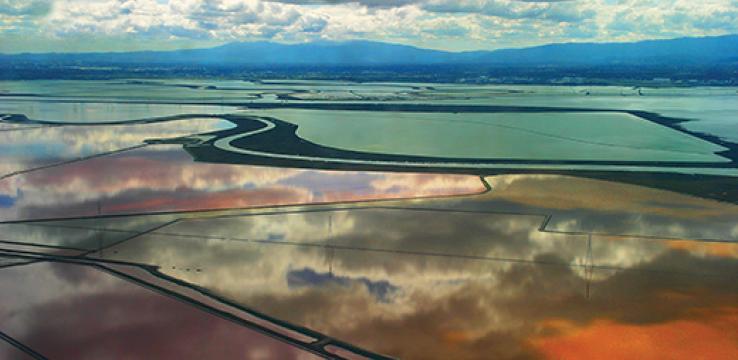How much higher will the oceans rise? No one knows, in part because of scientific uncertainty, but mostly because of political uncertainty. We don’t know if humanity will be capable of changing course, which really amounts to leaving a lot of fossil fuels in the ground, unburned.
Everyone knows the basic science by now: Burning fossil fuels releases greenhouse gases into the air. Greenhouse gases cause climate change. Greenhouse gases include carbon dioxide, methane, nitrous oxide and other heat-trapping gases. As we emit more of these noxious gases, global temperatures will rise. The concentration of these gases in the atmosphere today is higher than it’s been in the last 3 million years. The climate is already changing.
The oceans have not risen much yet, just about 8 inches over the last century. But the rate of increase is speeding up as the amount of carbon in the atmosphere increases. Current estimates for the year 2100 range from 1 to 6 feet of increase, with the current consensus falling in the middle of that range. But after 2100, the seas will keep going up. We are locked in to several centuries of sea level rise because of the greenhouse gases already in the atmosphere and the warming that has already taken place in the ocean.
There is uncertainty about how long it will take for the sea level increase that is already locked in to take place, but we do know it’s a matter of historical time, not geological time — of centuries, not millennia. If the Antarctic and Greenland ice sheets substantially melt, as they are predicted to with global temperature increases between 2 and 7 degrees Fahrenheit, they would contribute an additional 10 to 20 feet to sea level. The potential maximum, if we lost all the permanent ice on the earth, is 212 feet of sea level rise.
The geologic record shows warming periods in the past when sea levels were as high as 65 feet above current levels, but humans had not yet built hundreds of cities, home to billions of people, right along the coast.
AT&T Park Today

Climate change is the worst kind of problem for the human brain to solve as it’s too slow moving to give us the rush of adrenaline that signals “emergency.” Nickolay Lamm’s photo renderings of San Francisco’s AT&T Park now, paired with what it migh look like 25 feet under water, may help to illustrate that this is a problem we can no longer ignore.
AT&T Park Under 25 Feet of Sea Level Rise
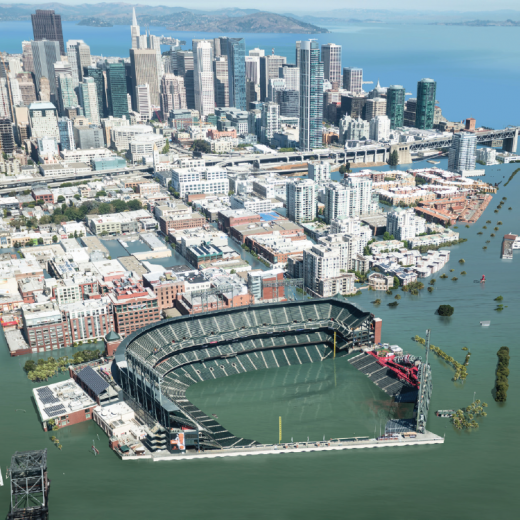
How likely is it that we will reduce our emissions in time to avoid the worst outcomes? How much more carbon are we going to emit?
The international community has set a goal of limiting global warming to fewer than 4 degrees Fahrenheit. That is the current consensus of the upper limit to avoid catastrophic climate change. Achieving it would require the total cessation of emissions once we have spirited 800 gigatons of carbon out of the ground and into the air. By 2011, we were already two-thirds of the way to this threshold, and global emissions rates continue to increase.
One way of thinking about the problem is that it comes down to how much fossil fuel we can leave in the ground. To keep warming below 4 degrees Fahrenheit, the International Energy Agency has found that we need to leave two-thirds of all known remaining reserves of coal, oil and gas in the ground, unburned. But will we be able to do that?
There is a name for the new geological epoch we have entered: the Anthropocene, the era in which humans have caused profound changes to the outer layer of the earth.
There is also a name for the period of historical time we have entered, which I suggest we take from Kim Stanley Robinson, one of the great writers of our time: the Dithering. As seen from Robinson’s science fiction–imagined future, this is the period of human history, following modernism and postmodernism, in which humanity failed to act rapidly or decisively enough to avert catastrophic climate change.
In the quarter-century since NASA scientist James Hansen alerted the public to the threat posed by human-caused global warming, emissions have only increased. It’s not that we have done nothing to address the problem; it’s that what we have done is so minimal that it is dwarfed by everything we’ve done to make the problem worse. I think it is fair to say that much of the general public, at least in the United States, has no idea just how far-reaching the changes are going to be if we continue down this path.
If we continue as we have, we are consigning the great coastal cities of the world to flooding. We can build wetlands and seawalls to protect what lies behind. But if the waters rise high enough, no barrier will be enough.
To any human, the prospect of losing coastal cities like San Francisco, New York, Shanghai, London, Barcelona, Tokyo, Mumbai and Venice is too horrifying to think about. Cities are one of our species’ greatest achievements, living monuments to the ingenuity and idealism that distinguish us and define our humanity. They are perhaps the most lasting of all things humans create. Architecture and streets, bridges and train lines, memorials and feats of engineering — all of the urban elements that give material form to our aspirations — are meant to be home and inspiration for generation after generation. Think of the shock people felt at the bombing of Dresden, the deliberate destruction of the giant Buddhas of Bamiyan or the looting of the Iraqi national museum. Multiply it by a thousand. The mind struggles to find metaphors to express what it would mean to lose the coastal cities of the world: like erasing the Koran and the Bible, Shakespeare and the Beatles, from our cultural memory — and losing them for good, unexcavatable for millennia except by underwater exploration.
Will we confine sea level rise to just 4 to 6 feet, which is probably the most optimistic conceivable scenario? Or will it go much, much higher?
Should we care about something that may not happen for hundreds of years? Of course we should; many children born this year will be alive in 2100. But can we get ourselves to care?
Climate change is the worst kind of problem for the human brain to cope with — something that is too slow moving to give us the rush of adrenaline that signals “emergency,” something that is so diffuse in its causes that it requires collective action at a scale that humanity has never managed. We all put it out of our minds most of the time. We all live life as normally as we can under the shadow of an increasingly uncertain “long run.”
On the other hand, the human brain is good at generating rationalizations and wishful thinking. Maybe we will invent new technologies capable of reversing climate change or neutralizing its effects — maybe something to suck carbon out of the atmosphere. In the meantime, most of what passes for action today is so underscaled as to be unnoticeable. We hope that somehow it will be enough.
Thus far, we are blocked from taking action at the national level. And at the international level, we don’t even have a conceivable way to compel the large countries of the world to work together. We all trust, or hope, that this will eventually change, as the effects of the changing climate hit harder. Hurricane Katrina didn’t get us to change our ways; neither did Hurricane Sandy. But maybe something will, some natural disaster of such epic proportions that no one will be able to avoid taking corrective action.
For now, most of the meaningful action is occurring at the state level. And here in California, there is a lot to be excited about. Awakened by the energy crisis of the 1970s, California began to use the lever of the state building code to require new construction to be ever more energy efficient — and we never looked back. We built a renewable portfolio standard that steadily increases how much of the electrical supply must come from renewable sources. We instituted a low-carbon fuel requirement for cars. And we now have a cap-and-trade system, the market solution that many economists believe could be the most effective tool of all to move our society toward carbon neutrality.
Figure 1: How High Will the Sea Rise?
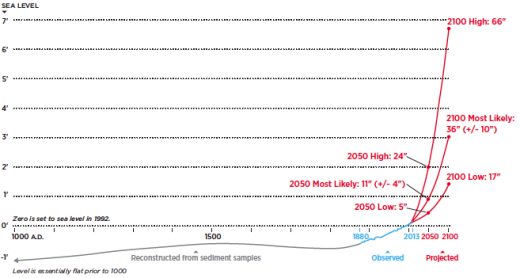
Sea levels, which have been relatively constant for the last 2000 years, rose 8 inches over the last century, and are accelerating. On the California coast, by 2050, we are likely to see 11 inches additional rise and by 2100, 36 inches of rise. Due to uncertainty, there is a wide range of estimated possibilities, from 17 to 66 inches by 2100.
Sources: Nationalgeographic.com, 2014, based on data from CSIRO, NASA, NOAA, and other sources; National Research Council, 2012.
Because a certain degree of climate change is now inevitable, we can’t just focus on fighting to reduce carbon emissions; we also have to focus on how to adapt to the changes we’ve already set in motion.
The first sets of climate impacts are already under way. They start out small. The road at Ocean Beach washes away; salt water intrudes into the overflow pipes of San Francisco’s sewers. So we install rocks on the beach to protect the Great Highway. We can add valves to the end of the sewer pipes, we can add sand to Ocean Beach and come up with a careful, engineered approach to helping the beach withstand at least the next 30 years of erosion.
Next, we will put in place a slightly more expensive set of fixes. We will restore salt ponds to wetlands to provide buffers against sea level rise and storms in the South Bay. We will elevate and waterproof buildings along the Embarcadero. We will give up on some piers over the water.
As soon as this fall, the voters of the Bay Area will have the chance to tax themselves to support regional wetlands restoration.
After that, we begin the harder work. In some places seawalls will be built. In others, we will remove buildings and return land to the ocean. Bridges will be elevated and subways will be waterproofed, to the best of our ability.
But unlike after an earthquake, the natural disaster we are so used to thinking about, things will not eventually go back to normal. The seas will keep rising, inexorably, decade after decade.
How much time can these measures buy us? Or, to say it differently, how many feet of sea level rise can a wetlands strategy or dune restoration program or even a higher seawall around San Francisco, buy us?
We’re in an era when there’s real mistrust of government and of big interventions of all kinds. We’ve scaled back our ambitions to tactical, temporary, small-scale approaches to change. But climate adaptation requires us to act at the level of the big systems.
We in the Bay Area have the opportunity to lead the way. We are highly educated. We have a culture that is open to change. We have a natural setting that inspires environmental values. We are not debating whether climate change is real. We have one of the strongest economies in the world, meaning we can generate the resources to take action. The Bay Area is probably one of the best-positioned places in the world to create a working model of how an urbanized coastal region can cope with climate change.
We need to be ambitious enough to try to retrofit our region to live within a carbon budget that is sustainable for the planet. In other words, we should be striving to make the Bay Area carbon neutral. It is possible to generate the vast majority of the region’s energy and transportation needs with renewable energy: wind, water and solar. It will take time, policy change and significant resources, but it is a goal worth aiming for.
With a population approaching 8 million people, the Bay Area is large enough to matter. Can we start to imagine getting a majority of the metro areas in the United States to move radically toward carbon neutrality? This is the role SPUR is playing in the fight against climate change. We are working to get the cities of the Bay Area to do what they do best: inaugurate the future. The Bay Area can model for the rest of the United States how to curb emissions and adapt to the climate change we’ve already locked ourselves into — while continuing to demonstrate that such measures do not come at the expense of prosperity. With any luck, we will be joined by other progressive, urbanized regions around the country to scale up our impact.
Figure 2: How Long Will It Take Our Climate to Stabilize?
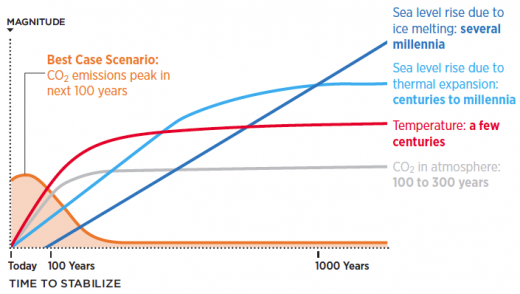
As Fig. 2 illustrates, even if we succeed at reducing emissions, it will take centuries to millennia for certain impacts of climate change, such as temperature increases and sea level rise, to level off.
Source: Bay Conservation and Development Commission, 2009
Figure 3: How Much Carbon Dioxide Is in the Air?
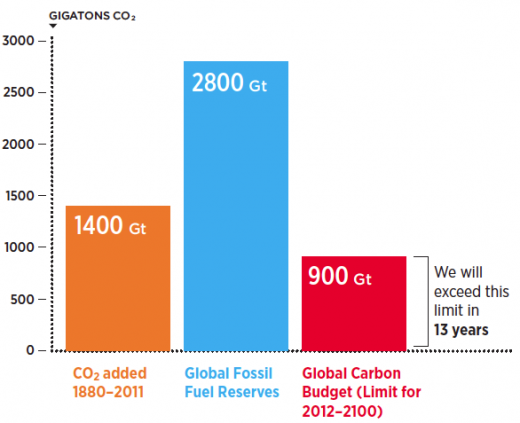
Since the industrial revolution, we have released about 1400 gigatons (one gigaton = 1 billion tons) of carbon dioxide into the atmosphere (see Fig. 3). Twice that amount is still left in the ground as known fossil fuel reserves. 900 gigatons is the amount which can still be released and keep the planet’s warming within 2 degrees Celsius, or what is believed to be the upper limit of “safe” climate change. At the current rate of emissions production, we will exceed that amount in less than 20 years.
Source: Carbontracker.org, 2012
What stands in the way of action to save the world?
At the local level in the Bay Area (and across California), we’ve created a system that requires years of meetings and process before anything can be done. High-speed rail is a perfect example of the kind of system-level change we need to be implementing quickly, creating a viable replacement for car travel and air travel, but it is taking decades. And while the Bay Area needs to channel all of its growth into walkable, transit-served locations, we still endlessly debate the merits of every individual building no matter how close to transit it is. If you believe that there is time urgency to cutting the American contribution to global climate change, the current system of endless process over action constitutes a moral failure.
But even if we succeed beyond our wildest dreams here in the Bay Area, our historical emissions and others’ continued emissions may cause sea level to rise to inundate our cities regardless.
In that case, some have asked if it makes sense to expend resources and so much of the world’s remaining carbon budget in locations that ultimately will have to be abandoned.
I believe strongly that it’s not time to give up yet. We have to do everything we can, while we can. If we can build a working prototype of a sustainable region; if we can provide millions of people with a high quality of life that does not harm the planet; if we can export our environmental values to the rest of the world, then surely it’s worth taking the risk that some of what we create might one day be lost.
In a spiritual sense, we have to accept the impermanence of our situation. Climate resiliency implies that things can go back to the way they were. This cannot be. We are entering an era of profound change and loss, no matter what we wish. Our task now is contradictory: to fight climate change even while we try to learn to live with it.

